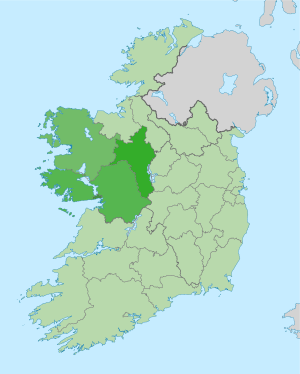West Region, Ireland facts for kids
Quick facts for kids
West
|
|
|---|---|

The West of Ireland with each local government area highlighted.
|
|
| Country | |
| Region | Northern and Western |
The West is a special area in Ireland. It's part of the Northern and Western Region. This area includes the counties of Galway, Mayo, and Roscommon. It also includes the city of Galway. The West is very large, covering about 13,801 square kilometers. In 2022, nearly 486,000 people lived here.
This region is on Ireland's western coast, next to the Atlantic Ocean. The River Shannon forms its eastern border. Most of the West is countryside, with only about 30% of people living in towns. It's famous for keeping Irish traditions alive. This includes speaking the Irish language in special areas called Gaeltachts.
Contents
How the West is Governed
The West has a group that helps plan for the future. This group is called the West Strategic Planning Area Committee. It's part of the Northern and Western Regional Assembly.
Local Councils and Representatives
Local councils from Galway City, County Galway, County Mayo, and County Roscommon send people to this assembly. These representatives work together to make important decisions for the region.
Past Governing Bodies
From 1994 to 2014, the West Region had a different governing body. It was called the West Regional Authority. This group had 28 elected people. They met once a month to discuss regional matters. In 2014, these older groups were replaced. Their jobs were taken over by the new Regional Assemblies.
People and Population
In 2022, the West region had 485,966 people living there. This is about 9.43% of all the people in Ireland. On average, there were 35 people living in each square kilometer. Galway City is the biggest city in the region. It had 85,910 people living there in 2022.
Economy and Tourism
The West region's economy is strong. In 2012, the total value of goods and services produced here was about €13.8 billion.
Attracting Visitors
Tourism is a very important part of the economy. The West's beautiful natural places bring in many visitors. People come from all over Ireland and other countries. They enjoy the rivers, lakes, mountains, and plains. The region also has many islands, lovely beaches, and a rugged coastline. These natural sights make the West a popular place to visit.
Getting Around the West
The West region has good ways to travel.
Air, Rail, and Road Connections
- The Ireland West Airport Knock is an international airport. You can fly from here to the United Kingdom and other parts of continental Europe.
- Train services connect Galway and Mayo to Dublin.
- The M6 motorway links Galway directly to Dublin. It was finished in 2009.
- The M17 motorway connects Shannon to the M6. It opened in 2010. Its short extension north to Tuam (called the M18 motorway) opened in 2017.
- The Western Railway Corridor was reopened in 2010. It now reaches Athenry, where it connects to the main Dublin-Galway railway line.
Main Towns and Cities
Here is a list of the largest urban areas in the West Region. The main towns for each county are shown in bold.
| Rank | Town | County | Population (2022 census) |
|---|---|---|---|
| 1 | Galway | Galway | 85,910 |
| 2 | Castlebar | Mayo | 13,054 |
| 3 | Ballina | Mayo | 10,556 |
| 4 | Tuam | Galway | 9,647 |
| 5 | Westport | Mayo | 6,872 |
| 6 | Ballinasloe | Galway | 6,597 |
| 7 | Roscommon | Roscommon | 6,555 |
| 8 | Loughrea | Galway | 6,322 |
| 9 | Oranmore | Galway | 5,819 |
| 10 | Athenry | Galway | 4,603 |
| 11 | Claremorris | Mayo | 3,857 |
| 12 | Ballinrobe | Mayo | 3,148 |
| 13 | Boyle | Roscommon | 2,915 |

